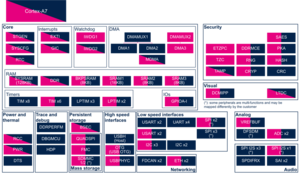1. Article purpose[edit | edit source]
The purpose of this article is to:
- briefly introduce the SPDIFRX peripheral and its main features
- indicate the level of security supported by this hardware block
- explain how each instance can be allocated to the runtime contexts and linked to the corresponding software components
- explain how to configure the SPDFIRX peripheral.
2. Peripheral overview[edit | edit source]
The SPDIFRX peripheral, is designed to receive an S/PDIF flow compliant with IEC-60958 and IEC-61937. The SPDIFRX receiver provides two separated paths to retrieve the audio data and the user and channel information.
2.1. Features[edit | edit source]
Refer to STM32MP13 reference manuals or STM32MP15 reference manuals for the complete feature list, and to the software components, introduced below, to see which features are implemented.
2.2. Security support[edit | edit source]
The SPDFIRX is a non secure peripheral.
3. Peripheral usage and associated software[edit | edit source]
3.1. Boot time[edit | edit source]
The SPDFIRX is not used at boot time.
3.2. Runtime[edit | edit source]
3.2.1. Overview[edit | edit source]
The SPDIFRX instance can be allocated to:
- the Arm® Cortex®-A7 non-secure for use in Linux with ALSA framework on STM32MP1 Series
- the Cortex-M4 for use in STM32Cube with STM32Cube SPDFIRX driver on STM32MP15x lines
 only
only
Chapter #Peripheral assignment exposes which instance can be assigned to which context.
3.2.2. Software frameworks[edit | edit source]
3.2.2.1. On STM32MP13x lines  [edit | edit source]
[edit | edit source]
| Domain | Peripheral | Software components | Comment | |
|---|---|---|---|---|
| OP-TEE | Linux | |||
| Audio | SPDIFRX | ALSA framework | ||
3.2.2.2. On STM32MP15x lines  [edit | edit source]
[edit | edit source]
| Domain | Peripheral | Software components | Comment | ||
|---|---|---|---|---|---|
| OP-TEE | Linux | STM32Cube | |||
| Audio | SPDIFRX | ALSA framework | STM32Cube SPDIFRX driver | ||
3.2.3. Peripheral configuration[edit | edit source]
The configuration is applied by the firmware running in the context to which the peripheral is assigned. The configuration can be done alone via the STM32CubeMX tool for all internal peripherals, and then manually completed (particularly for external peripherals), according to the information given in the corresponding software framework article.
When the Arm® Cortex®-A7 core operates in non-secure access mode, the SPDIFRX is controlled by the Linux kernel framework. Refer to the SPDIFRX Linux driver to drive the SPDIFRX through Linux kernel ALSA framework. Refer to Soundcard configuration and SPDIFRX device tree configuration to configure the SPDIFRX through Linux kernel device tree[1].
3.2.4. Peripheral assignment[edit | edit source]
3.2.4.1. On STM32MP13x lines  [edit | edit source]
[edit | edit source]
Check boxes illustrate the possible peripheral allocations supported by STM32 MPU Embedded Software:
- ☐ means that the peripheral can be assigned (☑) to the given runtime context.
- ⬚ means that the peripheral can be assigned to the given runtime context, but this configuration is not supported in STM32 MPU Embedded Software distribution.
- ✓ is used for system peripherals that cannot be unchecked because they are statically connected in the device.
Refer to How to assign an internal peripheral to a runtime context for more information on how to assign peripherals manually or via STM32CubeMX.
The present chapter describes STMicroelectronics recommendations or choice of implementation. Additional possiblities might be described in STM32MP13 reference manuals.
| Domain | Peripheral | Runtime allocation | Comment | ||
|---|---|---|---|---|---|
| Instance | Cortex-A7 secure (OP-TEE) |
Cortex-A7 non-secure (Linux) | |||
| Audio | SPDIFRX | SPDIFRX | ☐ | Assignment (single choice) | |
3.2.4.2. On STM32MP15x lines  [edit | edit source]
[edit | edit source]
Check boxes illustrate the possible peripheral allocations supported by STM32 MPU Embedded Software:
- ☐ means that the peripheral can be assigned (☑) to the given runtime context.
- ✓ is used for system peripherals that cannot be unchecked because they are statically connected in the device.
Refer to How to assign an internal peripheral to a runtime context for more information on how to assign peripherals manually or via STM32CubeMX.
The present chapter describes STMicroelectronics recommendations or choice of implementation. Additional possiblities might be described in STM32MP15 reference manuals.
| Domain | Peripheral | Runtime allocation | Comment | |||
|---|---|---|---|---|---|---|
| Instance | Cortex-A7 secure (OP-TEE) |
Cortex-A7 non-secure (Linux) |
Cortex-M4 (STM32Cube) | |||
| Audio | SPDIFRX | SPDIFRX | ☐ | ☐ | Assignment (single choice) | |
4. How to go further[edit | edit source]
The STM32H7 SPDIFRX training [2], introduces the STM32 S/PDIF Receiver interface on the STM32H7. This training also applies to the STM32 MPU SPDIFRX internal peripheral.
5. References[edit | edit source]

